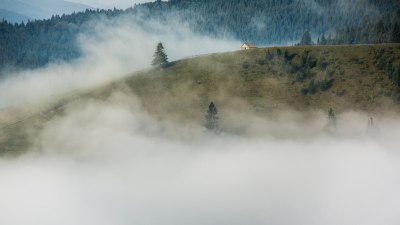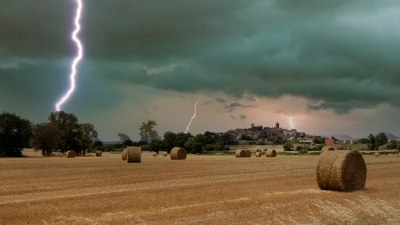How Fog Is Basically Nature’s Way of Saying "Chill Out"
Explore the calming nature of fog and its impact on ecosystems, meditation, and introspection.

Image by user21829937 on Freepik
Fog is often perceived as a mystical weather phenomenon, blanketing landscapes in a serene veil. Its soft, damp embrace can evoke feelings of tranquility, prompting us to slow down and appreciate our surroundings. In this article, we delve into the nature of fog, exploring its characteristics, how it influences our environment, and why it might just be nature's gentle reminder to 'chill out.'
Understanding Fog
Fog is essentially a cloud that forms close to the ground, consisting of tiny water droplets suspended in the air. It occurs when the air near the surface cools and saturates with moisture, creating low-lying clouds. There are various types of fog, including radiation fog, advection fog, and upslope fog, each generated by a distinct combination of temperature and moisture factors. Radiation fog develops during clear nights when the ground cools rapidly, while advection fog forms when warm, moist air moves over cooler surfaces. Regardless of the type, fog brings a sense of calm and stillness.
The Science Behind Fog Formation
The formation of fog requires specific conditions. The primary factors at play are temperature and humidity. When warm, moist air rises and cools, the capacity of the air to hold water vapor decreases, resulting in condensation. This process creates tiny droplets that cluster together, forming fog. The role of temperature inversions is also crucial; when a layer of warm air traps cooler air below, fog is likely to form. Thus, fog acts as a natural signal that conditions are right for its formation, reminding us to embrace the slower pace it brings.
Fog’s Role in Ecosystems
Beyond its aesthetic appeal, fog plays a vital role in various ecosystems. In coastal regions, for instance, fog serves as an essential source of moisture for plants and animals. Many desert environments, such as the coastal deserts of California and the Atacama Desert in Chile, depend on fog for hydration. The moisture from fog condenses on leaves and surfaces, providing life-sustaining water during arid conditions. This phenomenon is especially crucial for vegetation and wildlife that thrive in these regions, highlighting fog’s essential role in supporting ecological balance.
The Impact of Fog on Human Experience
Human perception of fog is deeply intertwined with culture, art, and emotion. The ethereal quality of fog often inspires artists, filmmakers, and poets, enabling them to convey themes of mystery, introspection, and tranquility. The Zen concept of 'mono no aware,' or the beauty of transient moments, resonates profoundly in fog's fleeting nature. The ephemeral presence of fog often mirrors life’s transient qualities, prompting moments of reflection and mindfulness.
Meditation and Mindfulness in Fog
In many cultures, fog serves as an ideal backdrop for meditation and contemplation. Its ability to soften the world around us creates a perfect canvas for self-reflection. Amidst the stillness introduced by fog, individuals can find a moment of peace and clarity. Practicing mindfulness in foggy conditions encourages us to embrace the present and quiet the noise of our busy lives. Engaging in mindful breathing exercises while enveloped in fog allows us to reconnect with ourselves, leading to heightened awareness and a sense of harmony with nature.
Fog as a Natural Sound Dampener
The thick presence of fog alters how sound travels, creating a unique auditory environment. Fog acts as a sound dampener, absorbing sound waves and diffusing them through moisture. This results in a quieter, almost surreal atmosphere. City streets transformed by a blanket of fog become hushed, inviting us to stop and savor the tranquility. The muffled sounds seem to encourage us to pause, defining fog as nature’s way of softening our auditory experiences as well.
The Psychology of Fog
Fog evokes a wide array of emotions, often associated with calmness or nostalgia. Psychologically, being in a foggy environment can evoke feelings of introspection, allowing individuals to reflect on their thoughts and emotions. This subtle shift in our surroundings can lead to a mindful exploration of one’s inner landscape. Psychologists note that natural settings, like fog-covered landscapes, can lower stress levels and improve overall well-being, delivering the psychological benefit of inducing a slower, calmer pace of life.
Fog and Urban Environments
In urban areas, fog brings a unique dynamic to the landscape. City skyscrapers disappear behind billowing clouds, introducing an enchanting yet eerie atmosphere. Foggy mornings often prompt slower commutes, as visibility decreases and motorists navigate cautiously. Individuals are urged to adapt to these foggy conditions, embracing a slower pace. This phenomenon encourages urban inhabitants to take a moment to pause, appreciating the city in a different light, or rather, in a different shade.
Photography in Fog
Photographers often see fog as a creative ally. The muted light and soft colors create dreamlike compositions, rendering images with emotional depth. Fog enhances contrasts, blurring lines between foreground and background, thereby creating an aura of mystery. The early morning fog can transform everyday scenes, presenting opportunities for stunning photography that captures nature's ethereal beauty. This art form encourages both photographers and viewers to appreciate the fleeting and transient nature of the world.
Regional Variations of Fog
Fog manifests differently across regions, influenced by local climates and geography. For example, the coastal fog of San Francisco is a renowned phenomenon, bringing cool air and moist conditions that define the city’s weather. In contrast, the fog of the Great Plains can lead to extended periods of low visibility and dramatically affects daily life and transportation. Understanding regional variations in fog allows for a deeper appreciation of its diverse forms and effects, reinforcing the idea that fog is nature's way of promoting awareness of our environment.
Embracing Fog: Lifestyle and Activities
How can we embrace fog in our daily lives? Taking a leisurely walk or engaging in outdoor activities during foggy weather offers a chance to immerse oneself in this unique atmosphere. Birdwatchers, nature enthusiasts, and hikers often find that fog enhances their experiences in natural settings. The mystical quality of touching a foggy landscape creates a bond between nature and individuals, encouraging a sense of belonging. Exploring parks or woodlands enveloped in fog ignites curiosity and awe, deepening our connection to the environment.
Chill Out with Fog
In conclusion, fog serves as a poignant reminder from nature to slow down, reflect, and connect with the world around us. It creates ecosystems rich with life, impacts human perceptions and emotions, and encourages moments of introspection. By embracing the presence of fog, we can savor its beauty, appreciate the stillness it brings, and allow ourselves to find peace amidst life's chaos. So next time you see fog rolling in, take a moment to enjoy the serenity it brings — after all, nature is simply saying, 'Chill out.'











